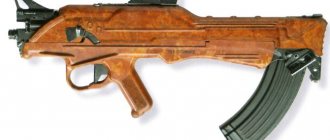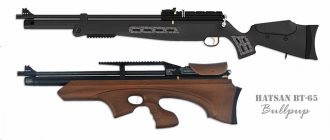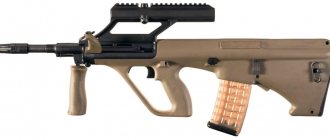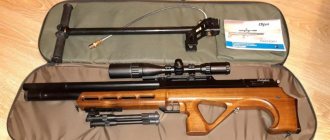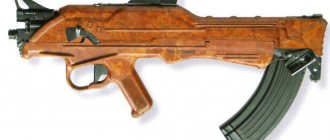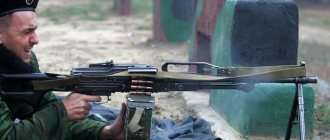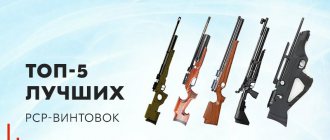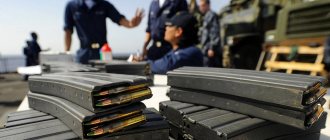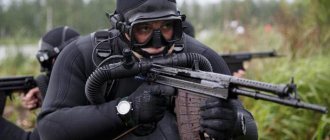Shooting "bulldog puppy"
The bullpup design refers to a small weapon in which the magazine, breech and firing mechanism (trigger) are located behind the fire control handle. The term "bullpup", according to weapons historian Maxim Popenker, probably comes from the English bulldog puppy - "bulldog puppy". Weapons of this configuration are 20-25 centimeters shorter than their traditional counterparts and look a little snub-nosed.
Bullpup assault rifles/machine guns appeared in the arsenal of modern armies in the 1970s, but the first samples were created at the beginning of the 20th century. Popenker gives the example of a certain Englishman Thorneycroft, who in 1901 proposed a cavalry carbine, where the magazine with cartridges was placed in the neck of the butt, and the bolt moved above the ridge of the butt when reloading. Thanks to this, the carbine with a barrel of 70 centimeters had a total length of just under a meter. For comparison: the length of a standard 1894 Lee Enfield cavalry carbine with a half-meter barrel was 101 centimeters. The price for the unusual design was a reduction in magazine capacity from 10 to 5 rounds, as well as very inconvenient reloading of the weapon. Thorneycroft's carbine remained an experimental model, like other bullpup models of the first half of the twentieth century.
Since the 40s, the bullpup circuit has been actively experimented with in the USA, Europe, and the USSR. In 1944, we had an experimental Prilutsky assault rifle chambered for a new cartridge of 7.62x39 millimeters. In 1951, the British not only developed, but also adopted the EM-2 bullpup rifle chambered for 7x43 millimeters. The project was curtailed under pressure from the United States - the Americans achieved the adoption of a single 7.62x51 cartridge in NATO armies. It was not possible to adapt the EM-2 to this powerful ammunition.
Specifications
The main specifications of the Kel-Tec KSG shotgun are as follows:
- caliber 12/70, 12/76;
- weapon length 660 mm;
- barrel length 470 mm;
- weapon width 76 mm;
- weight without cartridges 3.13 kg;
- loaded gun weight 3.85 kg;
- magazine capacity 14 (+1) rounds;
- approximate cost $880;
- USA manufacturer;
- designer George Kelgren;
- serial production from 2011 to the present.
Austrian legend
Bullpups really took off in the late 70s. In 1977, the Austrian Ministry of Defense adopted the Steyr AUG (Armee Universal Gewehr) assault rifle - its mass production continues to this day. Almost simultaneously, the French military received the FAMAS F1 assault rifle. Both models are built according to a bullpup design and are distinguished by an unusual futuristic design, but it is the AUG that is called an assault rifle that was ahead of its time.
French military with FAMAS machine guns
Photo: Pascal Deloche / Godong / Globallookpress.com
The Austrians were among the first to introduce a modular design to army weapons - the rifle can be disassembled into five main blocks in a few seconds: a plastic body with a pistol grip; trigger block, almost entirely made of plastic; a bolt frame with a bolt and a receiver with a quick-release barrel. Instead of the usual front and rear sights, the first Steyr AUG models had a 1.5x Swarovski optical sight; in later versions it was replaced with a Picatinny rail. Replacing the standard barrel with a heavier and longer one turned the machine gun into a sniper rifle or light machine gun. Although some experts believe that neither a full-fledged “sniper” nor a light machine gun came out of the AUG.
Video: STEYR MANNLICHER / YouTube
The innovative design, design and good fighting qualities provided the Austrian rifle with good export potential. Now the Steyr AUG is used by units in more than 40 countries and is quite popular in the civilian weapons market.
The French FAMAS was less fortunate - experts consider its semi-blowback design not very successful, and the rifle itself is not reliable enough and capricious in terms of ammunition. The export potential of the machine gun turned out to be low; as a result, the French produced about 400 thousand copies of FAMAS and curtailed production in the 90s. Now the Ministry of Defense of the Fifth Republic plans to replace FAMAS with weapons of a traditional layout.
Operating principle of Kel-Tec KSG
Reloading a repeating shotgun in the KSG is manual, carried out by a pump-action mechanism through the forward-reciprocating sliding of the forend. The shotgun fore-end itself is made of high-strength plastic and is connected to the bolt through two metal rods. The barrel channel is locked by a swing-type combat cylinder and engages the bolt with the tail of the barrel.
Two tubular magazines located horizontally under the KSG barrel are responsible for feeding cartridges, but only one is used at a time. Which cartridges will be taken from is regulated by switching a special lever, which is located at the bottom of the shotgun box. This switch has three states: left, right and center position, which allows you to empty the chamber or quickly throw ammunition into it.
The supply of ammunition from each magazine occurs sequentially, that is, first one magazine must be emptied, and then the second.
Soviet experiment
At least a dozen bullpup machines were created in the USSR in the 40-80s. Experimental Korovin assault rifle, Korobov assault rifle (TKB-408) - the latter participated in the competition for a 7.62-mm assault rifle for the Soviet army, but was unsuccessful.
In the early 60s, Korobov proposed two more samples: TKB-022 and TKB-059. TKB-022 turned out to be a bold design - a plastic body with metal inserts, the spent cartridge case was thrown forward through a special tube, the bolt moved in a vertical plane. With an equal barrel length, the TKB-022 turned out to be 11.5 centimeters shorter than the AKMS with the butt folded. At the same time, the balance of the TKB-022 was excessively shifted back; the magazine with cartridges was attached at the very end of the receiver/stock. The Soviet military was not impressed by the machine gun.
Korobov assault rifle TKB-408 1946
Photo: A.V. Karpenko / bastion-karpenko.ru
The design of the TKB-059 was even bolder and more unpromising: a three-barreled multiple rocket launcher with a shifted recoil impulse - the first two or three shots occur before the bolt group hits the rear of the receiver and the shooter feels the recoil. Fire from the TKB-059 was carried out either in bursts or in volleys of three shots.
A series of bullpups was born in the 80s as part of the Abakan project to search for weapons to replace the Kalashnikov assault rifle: Nikonov NA-2 and NA-4 assault rifles, Stechkin assault rifle, TKB-0146 (all with a shifted recoil impulse). As you know, a traditionally designed weapon, the Nikonov AN-94 assault rifle, won the Abakan competition.
In the late 90s, the Russian military received the OTs-14 “Groza” automatic grenade launcher system, but it did not gain popularity.
Advantages and disadvantages of Kel-Tec KSG
First of all, it’s worth talking about the strengths of the Kel-Tec KSG shotgun:
- Compact shotgun size due to bullpup design.
- Multi-charge.
- The KSG is designed to meet the combat requirements and challenges of the 21st century.
- Ability to load magazines with different types of ammunition. For example, buckshot and bullets. This will allow you to perform various combat missions.
- Convenient for working in a group, discharging spent cartridges under the feet and forward, and not to the side.
- The ability to use the magazine that is most comfortable (depending on your hand) for charging, while keeping a second magazine as a backup for an emergency.
- Good weapon balancing, both with a full magazine and with different amounts of ammunition.
- The shotgun can be used by both right-handed and left-handed people.
- The KSG is comfortable to shoot, and the movement after the first shot is comparable to any other gun.
Now let's move on to the disadvantages:
- The legislation of a number of countries requires changes in the design of the shotgun for its legal use in the country. For example, attaching a DTK (muzzle brake compensator).
- Lack of built-in sighting devices.
- The sight must be high. This feature makes it inconvenient to use some collimator sights. The KSG is ideal for scopes used in conjunction with an AR-15 rifle.
- Some people may find the magazine selector to be a little short. But an extended version can be purchased from Kel-Tec.
- The KSG lacks the traditional shotgun side ejection window through which a cartridge can be inserted.
- Full mastery of the shotgun requires a lot of time and thousands of practice shots.
Links[edit]
- Dalzell, Tom; Victor, Terry (November 27, 2014). A Concise Dictionary of New Partridge Slang and Non-Traditional English. Rutledge. paragraph 119. ISBN 978-1-317-62512-4.
- "The Origin of the Term 'Bullpup' – with Jonathan Ferguson". YouTube
. - ^ abcdef Dockery, Kevin (2007). Weapons of the future. Berkeley Gauge. paragraph 64, 93-95. ISBN 978-0-425-21750-4.
- Cutshaw, Charles W. (February 28, 2011). 21st Century Tactical Small Arms: The Complete Guide to Small Arms from Around the World. Iola, WI: Gun Digest Books. pp. 338–339. ISBN 978-1-4402-2709-7.
- Tilstra, Russell S. (21 March 2014). The Battle Rifle: Development and Use after World War II. McFarland. paragraph 18. ISBN 978-0-7864-7321-2.
- ↑
Sweeney, Patrick (25 February 2011).
"Kel Tech RFB". Gun Digest Book of Tactical Rifle: Owner's Manual
. Iola, WI: Krause Publications. pp. 73–75. ISBN 978-1-4402-1892-7. - ↑
Sweeney, Patrick (10 May 2004). Modern Law Enforcement Weapons and Tactics. Iola, WI: Krause Publications. item 189. ISBN. 1-4402-2684-9. - Reeves, James (2021-03-25). "A Year with Desert Tech MDRX (Review)". Firearms Blog
. Retrieved March 26, 2022. - ↑
Curtis 1866: The First Bullpup - with Jonathan Ferguson - Dugelby, Thomas B. (1984). Modern Military Bullpup Rifles: The EM-2 Concept Comes of Age. Collection variety. pp. 21–47. ISBN 978-0-88935-026-7.
- ^ ab Dugelby, Thomas B. (1980). EM-2: Concept and Design
. Toronto: collector's grade publications. pp. 258–260. ISBN 978-0-88935-002-1. - Cashner, Bob (August 20, 2013). FN FAL combat rifle. Bloomsbury Publishing. clause 12. ISBN 978-1-78096-904-6.
- ↑
Cunningham, Grant (1 October 2015). "The Bullpup Rifle Experiment, Part 4: Do They Have a Place in Your Home Defense Arsenal?" . - ↑
Crossley, Alex (1 September 2013). "Weapon Review: VLTOR AUG A3". - ^ab Lewis, Jack (28 February 2011). Assault weapons
. Iola, WI: Gun Digest Books. paragraph 51. ISBN 978-1-4402-2400-3. - Jump up
↑ Hogg, Ian (1 June 2003).
Pistols and Rifles: The Best Weapons from Around the World
. Globe Pequot Press. paragraph 36. ISBN 978-1-58574-835-8. - ↑
Lai, Benjamin (14 July 2016). Dragon's Teeth: China's People's Liberation Army—Its History, Traditions, and Air, Sea, and Land Capabilities in the 21st Century. Casemate. p. 220. ISBN 978-1-61200-389-4. - Rhianna
McNab, Chris (24 March 2016). The Barrett Rifle: Sniper and Anti-Material Rifles in the War on Terror. Bloomsbury Publishing. pp. 16–19. ISBN 978-1-4728-1102-8. - Dougherty, Martin J. (October 16, 2012). The SAS and Elite Forces Sniper Guide: Sniping Skills from the World's Elite Forces. Lyons Press. p. 92. ISBN 978-0-7627-8876-7.
- ^ abcdefg "Chronology of Desert Technology Development". deserttech.com
. - Mann, Richard Allen; Lee, Jerry (November 20, 2013). Gun Digest of Modern Gun Values: A Shooter's Guide to Guns, 1900 to the Present. Iola, WI: F+W Media. item 576. ISBN. 978-1-4402-3752-2.
- [ https://armyrecognition.com/may_2017_global_defense_security_news_industry/delivery_first_batch_400_hk416f_assault_rifles_french_army_10305173.html/
- New $59 million weapons package begins Defense Force deployment - Stuff.co.nz 16 June 2022
- Pauley, Roger (2004). Firearms: The Life Story of Technology. Greenwood Publishing Group. ISBN 0-313-32796-3.
- Westwood, David (2005). Rifles: An Illustrated History of Their Impact. ABC-CLIO. ISBN 1-85109-401-6.
Modifications
The Kel-Tec KSG shotgun was created for civilian use, so modifications were not initially planned. However, the rapid growth in popularity of the shotgun in law enforcement agencies forced Kel-Tec to reconsider its position and release additional variations of the gun:
- KSG 25. Model with a barrel length of 774.7 mm and a total length of 965.2 mm and magazines of 10 rounds. Weight 4.2 kg. Price: 1150 dollars.
- KSG Tactical. Version with a barrel length of 343 mm and a total length of 546 mm and magazines of 4 rounds. Weight 2.8 kg. Price: $1225.
- KSG Compact. Model with a barrel length of 470 mm and a total length of 663 mm, weight 3 kg and two magazines of 4 rounds. Price: 930 dollars.
Previously, there was a modification of the KSG Patrol, which had a barrel length of 16.1 inches (409 mm) and a total weapon length of 24 inches (610 mm), a capacity of one magazine of 5 rounds, but now it is temporarily not being produced.
The weapon, originally created for civilian use, turned out to be very successful and quickly gained popularity among the military and police of different countries (USA, South Korea, France). This was facilitated by several factors: a double separate magazine, which allows it to perform functions inaccessible to other shotguns, small dimensions and a shotgun design that meets the combat missions of the 21st century.
The interesting appearance did not go unnoticed by the creators of computer games. The Kel-Tec KSG shotgun is present in Point Blank, Warface and other games. In the popular film John Wick, the main character uses it.

